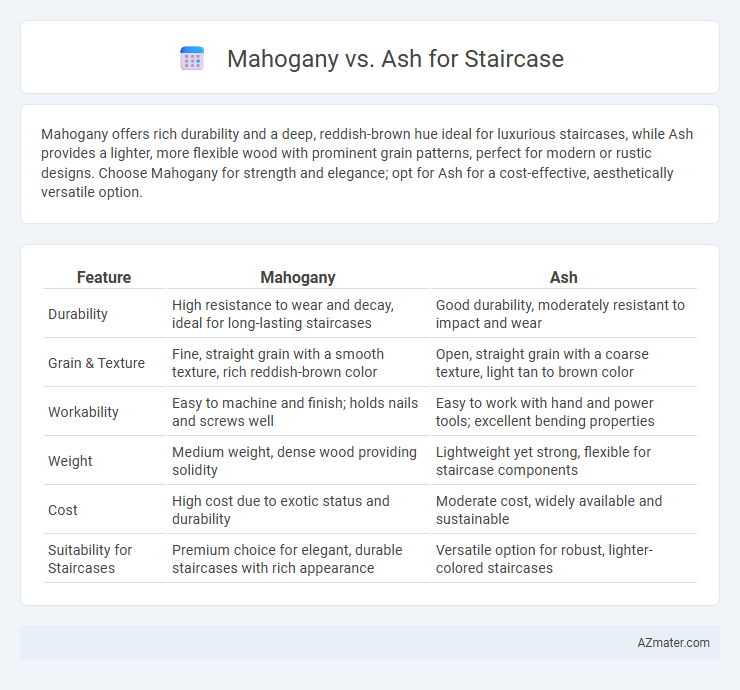Mahogany offers rich durability and a deep, reddish-brown hue ideal for luxurious staircases, while Ash provides a lighter, more flexible wood with prominent grain patterns, perfect for modern or rustic designs. Choose Mahogany for strength and elegance; opt for Ash for a cost-effective, aesthetically versatile option.
Table of Comparison
| Feature | Mahogany | Ash |
|---|---|---|
| Durability | High resistance to wear and decay, ideal for long-lasting staircases | Good durability, moderately resistant to impact and wear |
| Grain & Texture | Fine, straight grain with a smooth texture, rich reddish-brown color | Open, straight grain with a coarse texture, light tan to brown color |
| Workability | Easy to machine and finish; holds nails and screws well | Easy to work with hand and power tools; excellent bending properties |
| Weight | Medium weight, dense wood providing solidity | Lightweight yet strong, flexible for staircase components |
| Cost | High cost due to exotic status and durability | Moderate cost, widely available and sustainable |
| Suitability for Staircases | Premium choice for elegant, durable staircases with rich appearance | Versatile option for robust, lighter-colored staircases |
Introduction to Mahogany and Ash for Staircases
Mahogany and ash are premium hardwoods widely used for staircase construction due to their durability and aesthetic appeal. Mahogany, known for its rich reddish-brown color and fine grain, offers exceptional strength and resistance to wear, making it ideal for high-traffic areas. Ash features a lighter tone with a pronounced grain pattern, providing sturdy support and a contemporary look often favored in modern staircase designs.
Key Characteristics of Mahogany Wood
Mahogany is prized for its deep, rich reddish-brown hue and exceptional durability, making it ideal for staircases requiring both aesthetic appeal and long-term resilience. Its tight, straight grain pattern offers a smooth finish that enhances the elegance of staircase designs while resisting warping and shrinkage. The wood's natural resistance to decay and insects ensures maintenance ease, setting it apart from other hardwoods like ash.
Key Characteristics of Ash Wood
Ash wood is highly valued for staircases due to its durability, strength, and attractive light color with a pronounced grain pattern that adds visual interest to interiors. It has excellent shock resistance and flexibility, making it ideal for high-traffic areas where durability is essential. Ash's natural hardness and ease of staining allow it to mimic more expensive hardwoods while maintaining a cost-effective option for elegant, long-lasting staircases.
Durability and Strength Comparison
Mahogany offers exceptional durability and resistance to wear, making it ideal for high-traffic staircases with its dense, strong grain structure. Ash is known for its impressive bending strength and shock resistance, providing a resilient and flexible option for staircases subject to heavy use. Both hardwoods deliver excellent structural integrity, but mahogany surpasses ash in natural rot resistance, while ash excels in impact absorption.
Aesthetic Appeal: Color and Grain Differences
Mahogany offers a rich, deep reddish-brown color with a fine, straight grain that exudes warmth and elegance, making it ideal for classic or luxurious staircase designs. Ash features a lighter, creamy to pale brown hue with distinct, prominent grain patterns that create a more contemporary or rustic aesthetic. The contrasting color tones and grain textures between mahogany and ash allow homeowners to choose staircases that best complement their interior design themes.
Workability and Installation Considerations
Mahogany offers excellent workability due to its fine grain and smooth texture, allowing for precise cuts and intricate detailing in staircases. Ash, known for its strength and elasticity, can be more challenging to machine but provides superior durability and shock resistance, ideal for high-traffic staircases. During installation, mahogany's stability minimizes warping and shrinking, whereas ash requires careful moisture control to prevent potential expansion or contraction issues.
Cost Differences: Mahogany vs Ash
Mahogany is typically more expensive than ash due to its dense grain, durability, and rich, reddish-brown color, making it a premium choice for staircases. Ash is more cost-effective, offering a lighter color and moderate hardness, which balances aesthetics and budget without sacrificing strength. The price gap between mahogany and ash can significantly impact the overall staircase cost, with mahogany often costing 30-50% more per board foot depending on quality and source.
Maintenance and Longevity
Mahogany staircases require regular polishing to maintain their rich color and prevent surface wear, offering excellent resistance to rot and insects, which extends their longevity in humid environments. Ash wood is highly durable with natural shock resistance, demanding minimal maintenance beyond routine cleaning and occasional sealing to protect against moisture and wear. Both woods provide long-lasting staircase solutions, but mahogany's maintenance needs are higher due to its dense grain, while ash offers a more straightforward upkeep for extended durability.
Suitability for Modern and Traditional Designs
Mahogany's rich, reddish-brown tones and fine grain make it ideal for traditional staircase designs, offering warmth and classic elegance. Ash features a lighter color and pronounced grain pattern, providing a contemporary, airy look perfect for modern interiors. Both woods offer durability, but mahogany suits ornate styles while ash complements minimalist, sleek aesthetics.
Final Recommendations: Choosing the Best Wood for Your Staircase
Mahogany offers exceptional durability, rich color, and a fine grain, making it ideal for high-end staircases requiring strong wear resistance and elegant appeal. Ash provides excellent strength, a lighter natural tone, and price efficiency, suitable for contemporary designs needing sturdy yet cost-effective materials. For luxurious, long-lasting staircases, mahogany is recommended, while ash suits budget-conscious projects emphasizing strength and versatility.

Infographic: Mahogany vs Ash for Staircase
 azmater.com
azmater.com